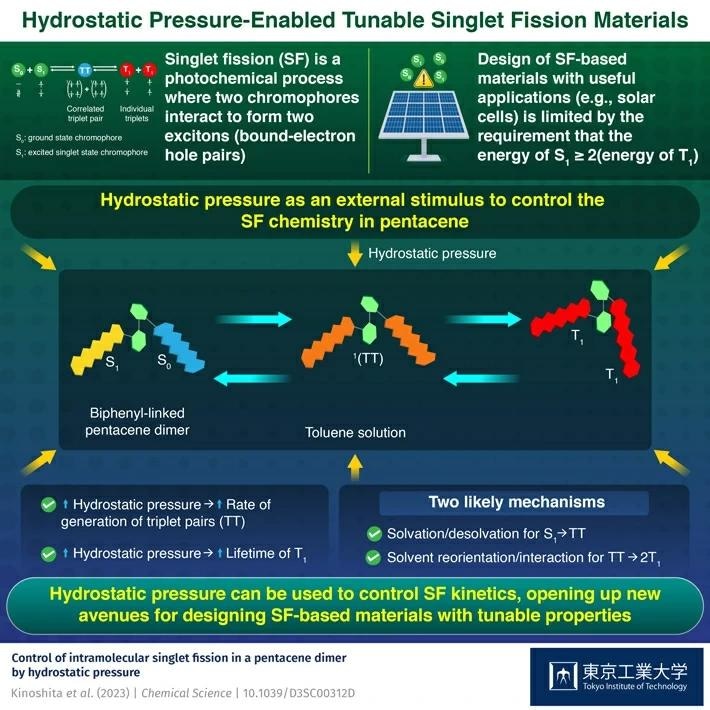Tokyo Tech and Keio University scientists show a new method to manage singlet fission (SF) by applying hydrostatic pressure as an external stimulus. This is a method in which two electrons are produced from a single photon, in chromophores, which paves the way to developing SF-based materials with improved (photo) energy conversion. Their method outweighs the stringent needs that restrict the molecular design of those materials by establishing a substitute control strategy.

Image Credit: Tokyo Institute of Technology
Singlet fission (SF) is an approach in which an organic chromophore (a molecule that absorbs light) transfers energy to an adjoining chromophore in an excited singlet state, which leads to two correlated triplet exciton pairs (pairs of bound electron-hole states, a “hole” signifying the absence of an electron) that decay to low energy triplet excitons. These excitons come with effective light emission and long lifetimes, which make SF promising for successful light energy conversion.
The molecular design of SF-based materials is, however, restricted by the need that the energy of the excited singlet state needs to be at least equal to the energy of the two triplet states. One method to surpass this limit is applying external stimuli, like pressure or temperature, for SF process manipulation.
Currently, Prof. Gaku Fukuhara of Tokyo Institute of Technology (Tokyo Tech) and Prof. Taku Hasobe of Keio University in Japan show a hydrostatic pressure-based strategy for managing the dynamics of the SF process, for the first time, paving the way to the fabrication and design of new, tunable SF-based materials. This collaborative study was published in Chemical Science.
“We demonstrated hydrostatic pressure-controlled formation and dissociation of correlated triplet pairs in SF by means of pressure-dependent UV/vis and fluorescence spectrometry along with fluorescence lifetime and nanosecond transient absorption measurements,” describe Prof. Fukuhara and Prof. Hasobe.
In their research, the scientists employed a biphenyl-bridged pentacene dimer as the model chromophore and assessed its response for a variety of hydrostatic pressures, between 0.1 MPa (atmospheric pressure) and 180 MPa, in three different solvents: methylcyclohexane, toluene, and tetrahydrofuran.
With a tailor-made high-pressure apparatus, the scientists measured the rate of exciton production at various pressures by tracking the fluorescence lifetime decay of the chromophore, indicating the time consumed by the chromophore to emit a photon after the first excitation. They discovered that the rate constant for producing correlated triplet exciton pairs amplified with pressure, which showed that higher pressure results in a faster SF process.
With the nanosecond transient absorption technique, the scientists then monitored the decay of the triplet excitons and discovered them to have reduced lifespans in high pressure.
Depending on thermodynamic estimations and quantum yield calculation, the scientists discovered two mechanisms that form the basis for generating individual excitons and correlated pairs. As far as correlated exciton pairs are concerned, the SF process was influenced by the desolvation and solvation of the molecule, resulting in a more thermodynamically stable and compact exciton structure compared to the excited chromophore.
On the contrary, the individual excitons generated by the dissociation process were discovered to be thermodynamically heavier, making the solvent molecules group around and deactivate them under high pressures.
Using these outcomes, the scientists have shown insights into the interactions among the different systems (solvent, pressure, excitons, chromophore) involved in the SF process, proposing an ideal substitute to the traditional control strategy for SF.
“Our study provides a new perspective on the control of intramolecular SF using hydrostatic pressure as an external stimulus. This dynamic control concept could be extended to other SF scaffolds and relevant systems that are difficult to control in both ground and excited states,” Prof. Fukuhara and Prof. Hasobe speculate.
They believe that the application of SF-based materials could be applied to the development of effective organic solar cells and photo-conversion devices.
Journal Reference:
Kinoshita, T., et al. (2023). Control of intramolecular singlet fission in a pentacene dimer by hydrostatic pressure. Chemical Science. https://doi.org/10.1039/d3sc00312d.